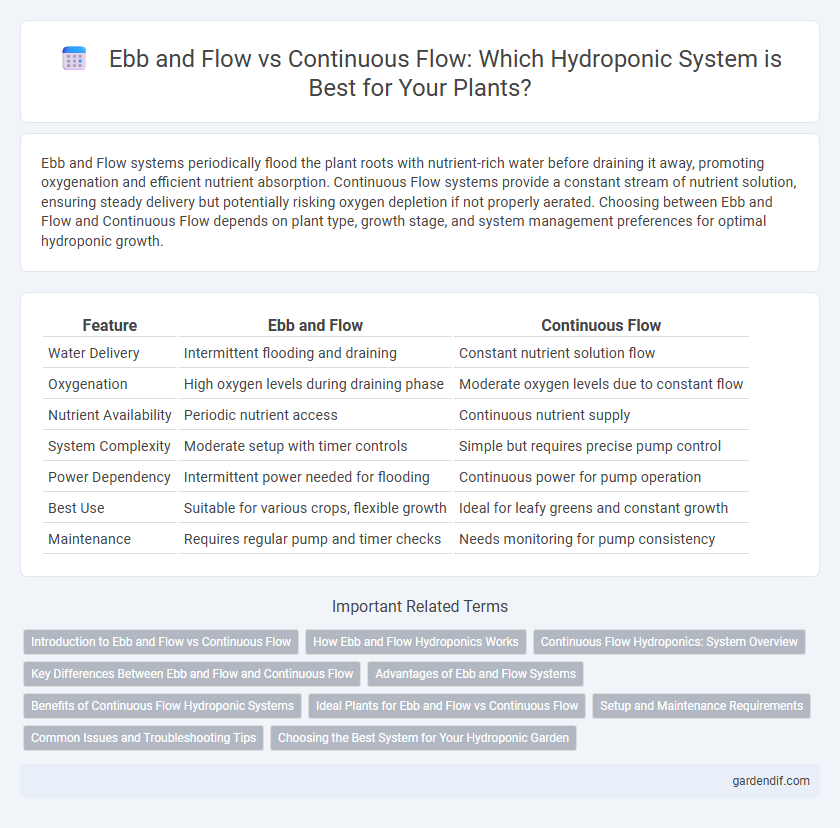
Ebb and Flow vs Continuous Flow Illustration
Ebb and Flow systems periodically flood the plant roots with nutrient-rich water before draining it away, promoting oxygenation and efficient nutrient absorption. Continuous Flow systems provide a constant stream of nutrient solution, ensuring steady delivery but potentially risking oxygen depletion if not properly aerated. Choosing between Ebb and Flow and Continuous Flow depends on plant type, growth stage, and system management preferences for optimal hydroponic growth.
Table of Comparison
| Feature | Ebb and Flow | Continuous Flow |
|---|---|---|
| Water Delivery | Intermittent flooding and draining | Constant nutrient solution flow |
| Oxygenation | High oxygen levels during draining phase | Moderate oxygen levels due to constant flow |
| Nutrient Availability | Periodic nutrient access | Continuous nutrient supply |
| System Complexity | Moderate setup with timer controls | Simple but requires precise pump control |
| Power Dependency | Intermittent power needed for flooding | Continuous power for pump operation |
| Best Use | Suitable for various crops, flexible growth | Ideal for leafy greens and constant growth |
| Maintenance | Requires regular pump and timer checks | Needs monitoring for pump consistency |
Introduction to Ebb and Flow vs Continuous Flow
Ebb and Flow hydroponic systems operate by periodically flooding the grow tray with nutrient solution, allowing roots to absorb nutrients before draining the solution back into the reservoir, ensuring oxygen-rich root zones. Continuous Flow systems, such as Nutrient Film Technique (NFT), maintain a constant, steady stream of nutrient solution flowing over the roots, promoting consistent nutrient uptake and oxygen exposure. Understanding the differences in nutrient delivery and oxygen availability between Ebb and Flow and Continuous Flow systems is crucial for optimizing plant growth in hydroponic setups.
How Ebb and Flow Hydroponics Works
Ebb and Flow hydroponics operates by periodically flooding the grow tray with nutrient-rich water, then draining it back into a reservoir, creating a rhythmic cycle that promotes oxygenation and nutrient absorption. This system uses a timer-controlled pump to ensure roots receive alternating periods of nutrient exposure and aeration, enhancing plant growth and preventing root rot. Compared to continuous flow systems, Ebb and Flow offers more precise control over moisture levels and reduces water waste through cyclical flooding.
Continuous Flow Hydroponics: System Overview
Continuous Flow Hydroponics involves a steady, unbroken circulation of nutrient-rich water to plant roots, ensuring constant access to essential minerals and oxygen. This method enhances growth rates and nutrient uptake by maintaining optimal moisture levels and preventing root dehydration. Compared to Ebb and Flow systems, Continuous Flow offers more precise control over nutrient delivery and reduces stress caused by fluctuating water availability.
Key Differences Between Ebb and Flow and Continuous Flow
Ebb and Flow systems periodically flood the plant roots with nutrient solution, allowing nutrient absorption followed by drainage, which enhances oxygen availability and prevents root rot. Continuous Flow systems maintain a steady, constant flow of nutrient solution over roots, promoting consistent nutrient delivery but requiring precise flow control to avoid waterlogging. Key differences include nutrient delivery timing, oxygenation levels, and system complexity, with Ebb and Flow offering cyclical wet-dry cycles and Continuous Flow providing uninterrupted nutrient exposure.
Advantages of Ebb and Flow Systems
Ebb and flow hydroponic systems provide efficient nutrient delivery by cyclically flooding and draining grow trays, ensuring roots receive ample oxygen and nutrients without waterlogging. This method reduces water and nutrient waste, promoting healthier plant growth and minimizing the risk of root diseases compared to continuous flow systems. The adaptability of ebb and flow systems allows for easy integration of various crop types and growth stages, enhancing overall system versatility.
Benefits of Continuous Flow Hydroponic Systems
Continuous flow hydroponic systems promote constant nutrient and oxygen delivery to plant roots, resulting in faster growth rates and higher yields compared to ebb and flow systems. These systems reduce the risk of root diseases by maintaining stable environmental conditions and preventing water stagnation. Continuous flow setups also require less frequent maintenance and offer enhanced scalability for commercial hydroponic farming operations.
Ideal Plants for Ebb and Flow vs Continuous Flow
Ebb and Flow systems are ideal for a wide variety of plants including leafy greens, herbs, and strawberries, as the periodic flooding and draining enhance oxygen availability to roots, promoting robust growth. Continuous Flow systems are better suited for plants with high nutrient demands and rapid growth cycles, such as lettuce, tomatoes, and cucumbers, because the constant nutrient supply ensures steady development and optimal hydration. Both systems optimize water and nutrient delivery but cater to different plant growth habits and oxygenation needs.
Setup and Maintenance Requirements
Ebb and Flow systems require periodic flooding and draining cycles that necessitate pumps with timers and root zone aeration, resulting in moderate setup complexity and regular maintenance to prevent clogging and pump failure. Continuous Flow systems involve a constant nutrient solution movement through channels, demanding a more intricate setup with precise flow regulation and consistent filtration to avoid algae and debris buildup, increasing maintenance efforts. Both systems need careful monitoring of water levels and nutrient concentrations but differ in mechanical components and frequency of operational checks.
Common Issues and Troubleshooting Tips
Ebb and Flow systems often face root rot and pump failure due to periodic flooding and draining cycles, while Continuous Flow systems commonly experience channel clogging and nutrient imbalance from constant water circulation. To troubleshoot Ebb and Flow, ensure proper drainage, maintain pump functionality, and monitor moisture levels to prevent waterlogging. For Continuous Flow, regularly clean channels, adjust nutrient solution concentration, and optimize flow rates to avoid stagnation and nutrient deficiencies.
Choosing the Best System for Your Hydroponic Garden
Ebb and Flow hydroponic systems cyclically flood and drain the growing medium, promoting strong root oxygenation and nutrient uptake, making them ideal for a variety of crops with moderate water needs. Continuous Flow systems provide a steady nutrient solution, optimizing growth for fast-growing, water-loving plants like lettuce and herbs through constant root hydration. Selecting the best system depends on factors such as crop type, water availability, space constraints, and maintenance preferences to maximize yield and resource efficiency in your hydroponic garden.
Ebb and Flow vs Continuous Flow Infographic

 gardendif.com
gardendif.com